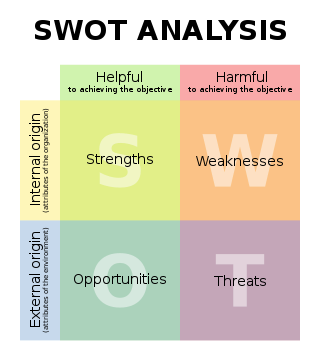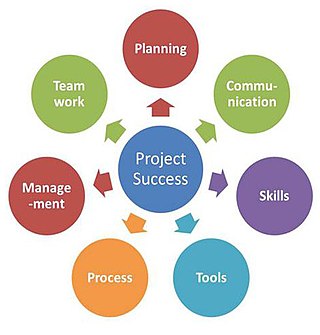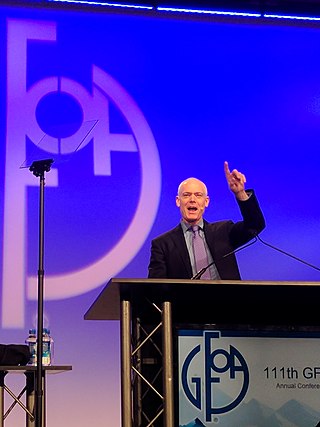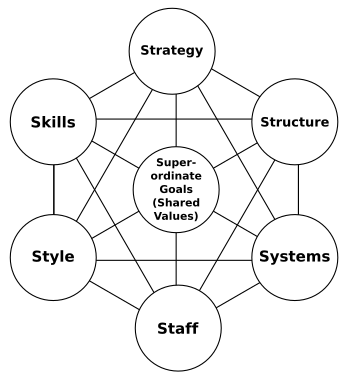In the field of management, strategic management involves the formulation and implementation of the major goals and initiatives taken by an organization's managers on behalf of stakeholders, based on consideration of resources and an assessment of the internal and external environments in which the organization operates. Strategic management provides overall direction to an enterprise and involves specifying the organization's objectives, developing policies and plans to achieve those objectives, and then allocating resources to implement the plans. Academics and practicing managers have developed numerous models and frameworks to assist in strategic decision-making in the context of complex environments and competitive dynamics. Strategic management is not static in nature; the models can include a feedback loop to monitor execution and to inform the next round of planning.

Porter's Five Forces Framework is a method of analysing the operating environment of a competition of a business. It draws from industrial organization (IO) economics to derive five forces that determine the competitive intensity and, therefore, the attractiveness of an industry in terms of its profitability. An "unattractive" industry is one in which the effect of these five forces reduces overall profitability. The most unattractive industry would be one approaching "pure competition", in which available profits for all firms are driven to normal profit levels. The five-forces perspective is associated with its originator, Michael E. Porter of Harvard University. This framework was first published in Harvard Business Review in 1979.

SWOT analysis is a strategic planning and strategic management technique used to help a person or organization identify Strengths, Weaknesses, Opportunities, and Threats related to business competition or project planning. It is sometimes called situational assessment or situational analysis. Additional acronyms using the same components include TOWS and WOTS-UP.
The word ‘dynamics’ appears frequently in discussions and writing about strategy, and is used in two distinct, though equally important senses.
Thomas J. Peters is an American writer on business management practices, best known for In Search of Excellence

McKinsey & Company is a worldwide management consulting firm founded in 1926 by University of Chicago professor James O. McKinsey, that offers professional services to corporations, governments, and other organizations. McKinsey is the oldest and largest of the "Big Three" management consultancies (MBB). The firm mainly focuses on the finances and operations of their clients.

Critical success factor (CSF) is a management term for an element that is necessary for an organization or project to achieve its mission. To achieve their goals they need to be aware of each key success factor (KSF) and the variations between the keys and the different roles key result area (KRA).

Kearney is an American global management consulting firm with offices in more than 40 countries worldwide. Kearney's predecessor firm was founded in Chicago by James O. McKinsey in 1926; he hired Andrew Thomas "Tom" Kearney as his first partner in 1929. After James McKinsey died in 1937, the Chicago office split into its own company, led by Tom Kearney and called McKinsey, A.T. Kearney, and Company. In 1947, it was renamed A.T. Kearney and Company.
In Search of Excellence is a book written by Tom Peters and Robert H. Waterman Jr. First published in 1982, it sold three million copies in its first four years, and was the most widely held monograph in the United States from 1989 to 2006. The book explores the art and science of management used by several companies in the 1980s.
Robert H. Waterman Jr. was a non-fiction author and expert on business management practices.
Intrapreneurship is the act of behaving like an entrepreneur while working within a large organization. Intrapreneurship is known as the practice of a corporate management style that integrates risk-taking and innovation approaches, as well as the reward and motivational techniques, that are more traditionally thought of as being the province of entrepreneurship. Corporate entrepreneurship is a more general term referring to entrepreneurial actions taking place within an existing organization whereas Intrapreneurship refers to individual activities and behaviors.

James C. "Jim" Collins is an American researcher, author, speaker and consultant focused on the subject of business management and company sustainability and growth.
The following outline is provided as an overview of and topical guide to business management:
An operating model is both an abstract and visual representation (model) of how an organization delivers value to its customers or beneficiaries as well as how an organization actually runs itself.
Organizational ethics is the ethics of an organization, and it is how an organization responds to an internal or external stimulus. Organizational ethics is interdependent with the organizational culture. Although it is to both organizational behavior and industrial and organizational psychology as well as business ethics on the micro and macro levels, organizational ethics is neither organizational behavior nor industrial and organizational psychology, nor is it solely business ethics. Organizational ethics express the values of an organization to its employees and/or other entities irrespective of governmental and/or regulatory laws.
Talent management (TM) is the anticipation of required human capital for an organization and the planning to meet those needs. The field has been growing in significance and gaining interest among practitioners as well as in the scholarly debate over the past 10 years, particularly after McKinsey's 1997 research and the 2001 book on The War for Talent. Michaels, Ed; Handfield-Jones, Helen; Axelrod, Beth (2001). The War for Talent. Harvard Business Press. ISBN 9781578514595. Talent management in this context does not refer to the management of entertainers. Talent management is the science of using strategic human resource planning to improve business value and to make it possible for companies and organizations to reach their goals. Everything done to recruit, retain, develop, reward and make people perform forms a part of talent management as well as strategic workforce planning. A talent-management strategy should link to business strategy and to local context to function more appropriately
Capability management is the approach to the management of an organization, typically a business organization or firm, based on the "theory of the firm" as a collection of capabilities that may be exercised to earn revenues in the marketplace and compete with other firms in the industry. Capability management seeks to manage the stock of capabilities within the firm to ensure its position in the industry and its ongoing profitability and survival.
Strategic alignment is a process that ensures an organization's structure, use of resources support its strategy. "In its simplest form, organizational strategic alignment is lining up a business' strategy with its culture." Successful outcomes also require an awareness of the wider environment, regulatory issues and technological change. Strategic alignment contributes to improved performance by optimizing the operation of processes/systems, and the activities of teams and departments. Goal-setting theory supports the relevance of clear, measurable operational objectives that can be linked to superordinate goals. This helps ensure resources are used effectively.
In organizational theory, organizational analysis or industrial analysis is the process of reviewing the development, work environment, personnel, and operation of a business or another type of association. This review is often performed in response to crisis, but may also be carried out as part of a demonstration project, in the process of taking a program to scale, or in the course of regular operations. Conducting a periodic detailed organizational analysis can be a useful way for management to identify problems or inefficiencies that have arisen in the organization but have yet to be addressed, and develop strategies for resolving them.
The following outline is provided as an overview of and topical guide to consulting:






